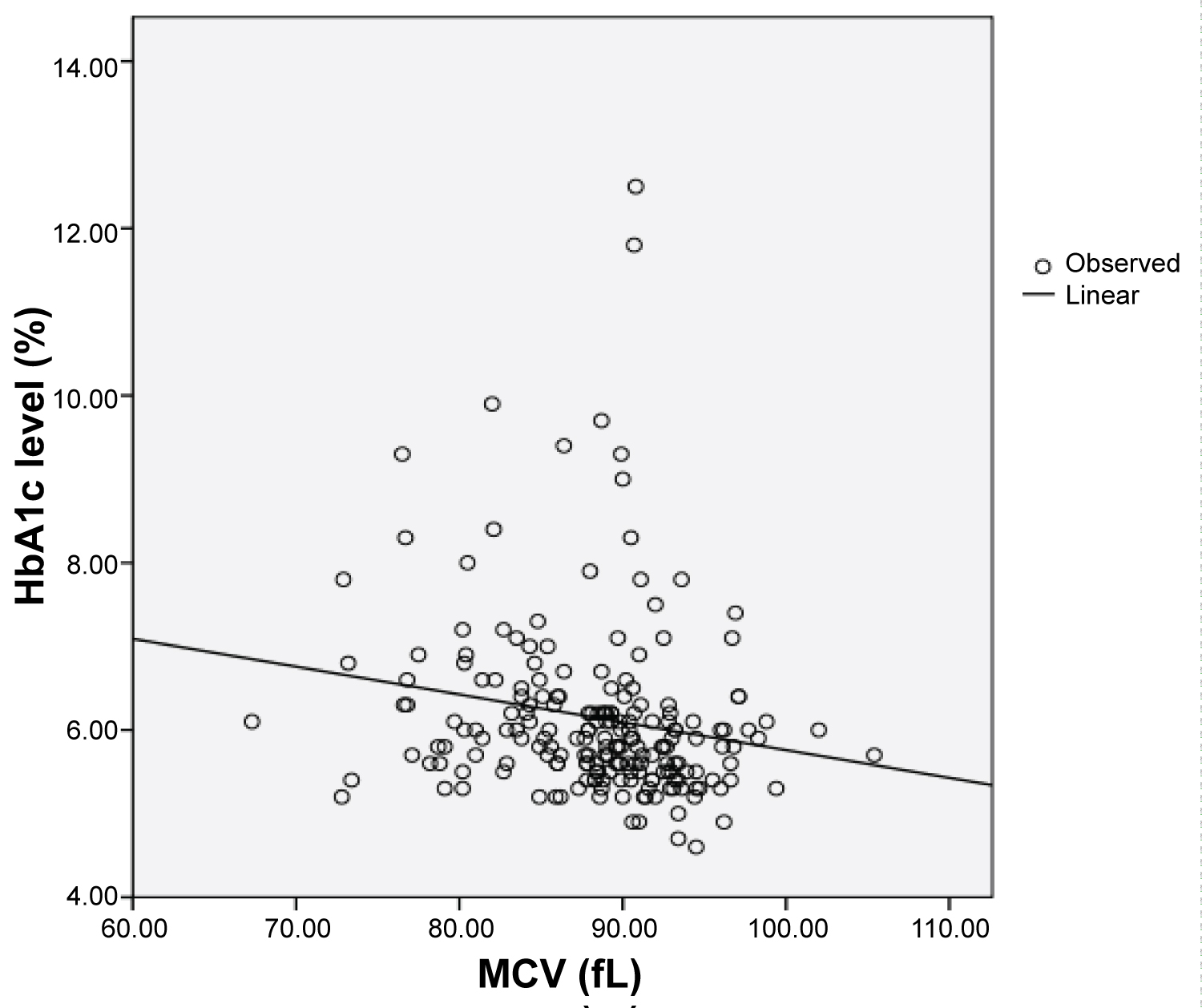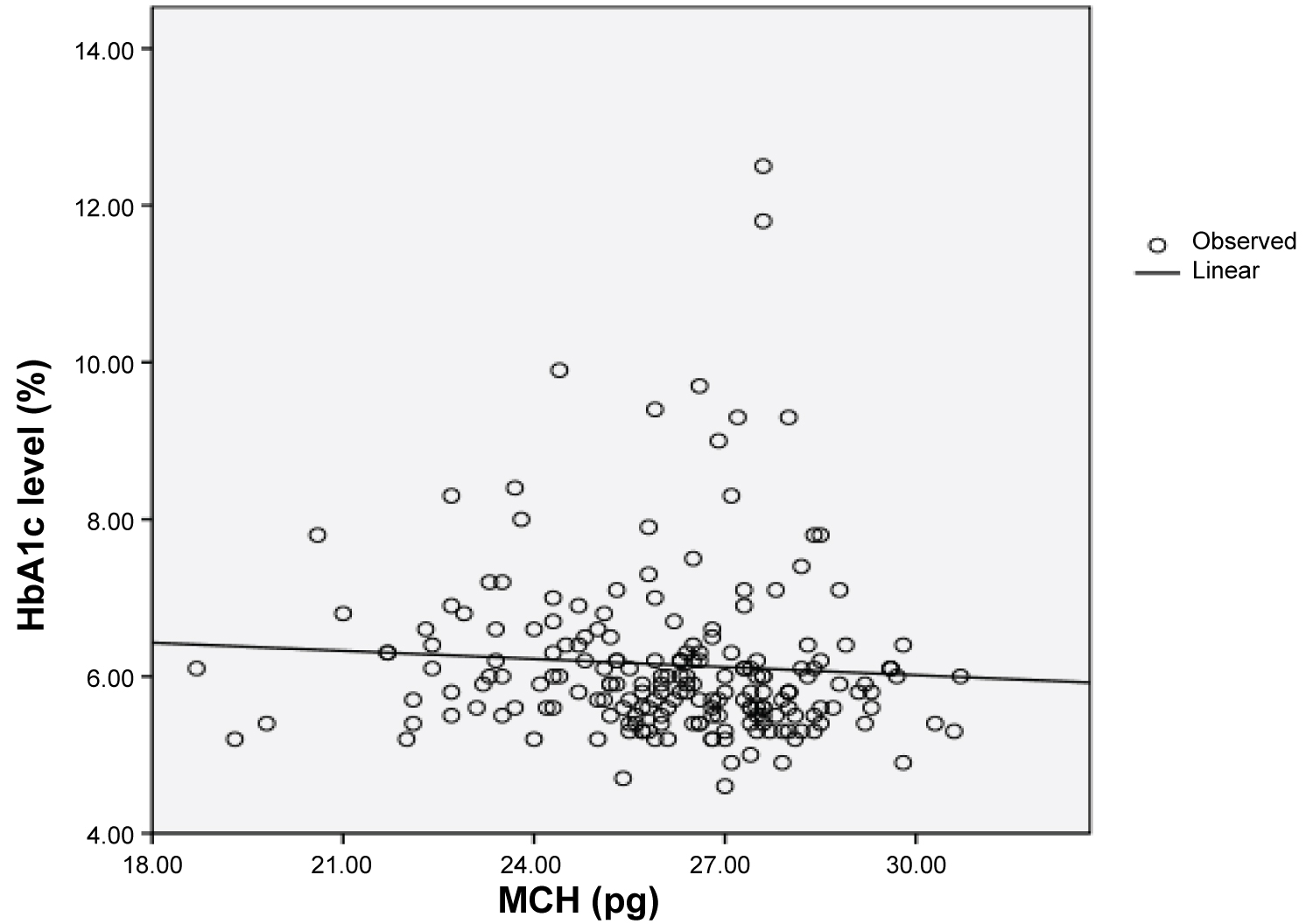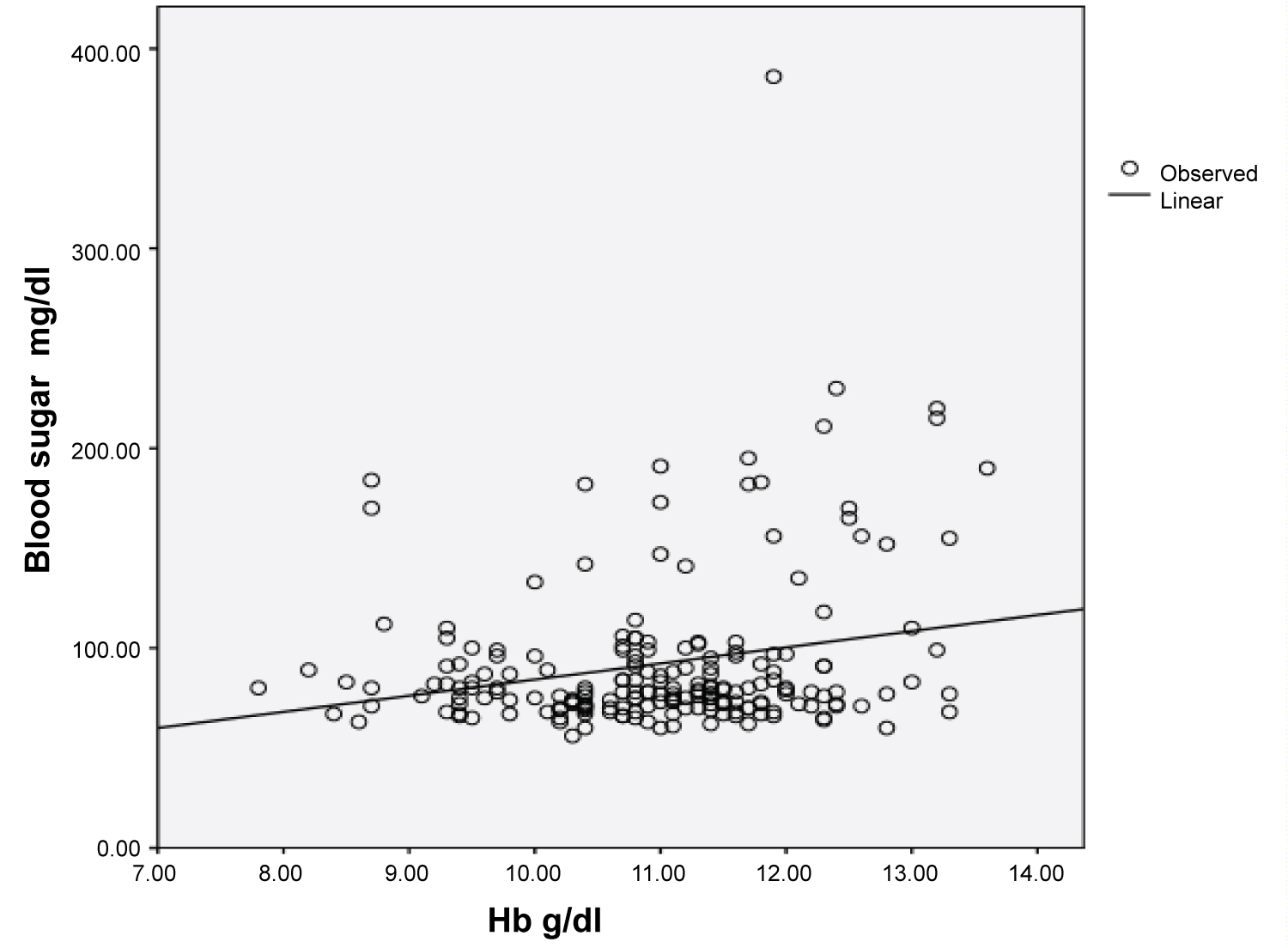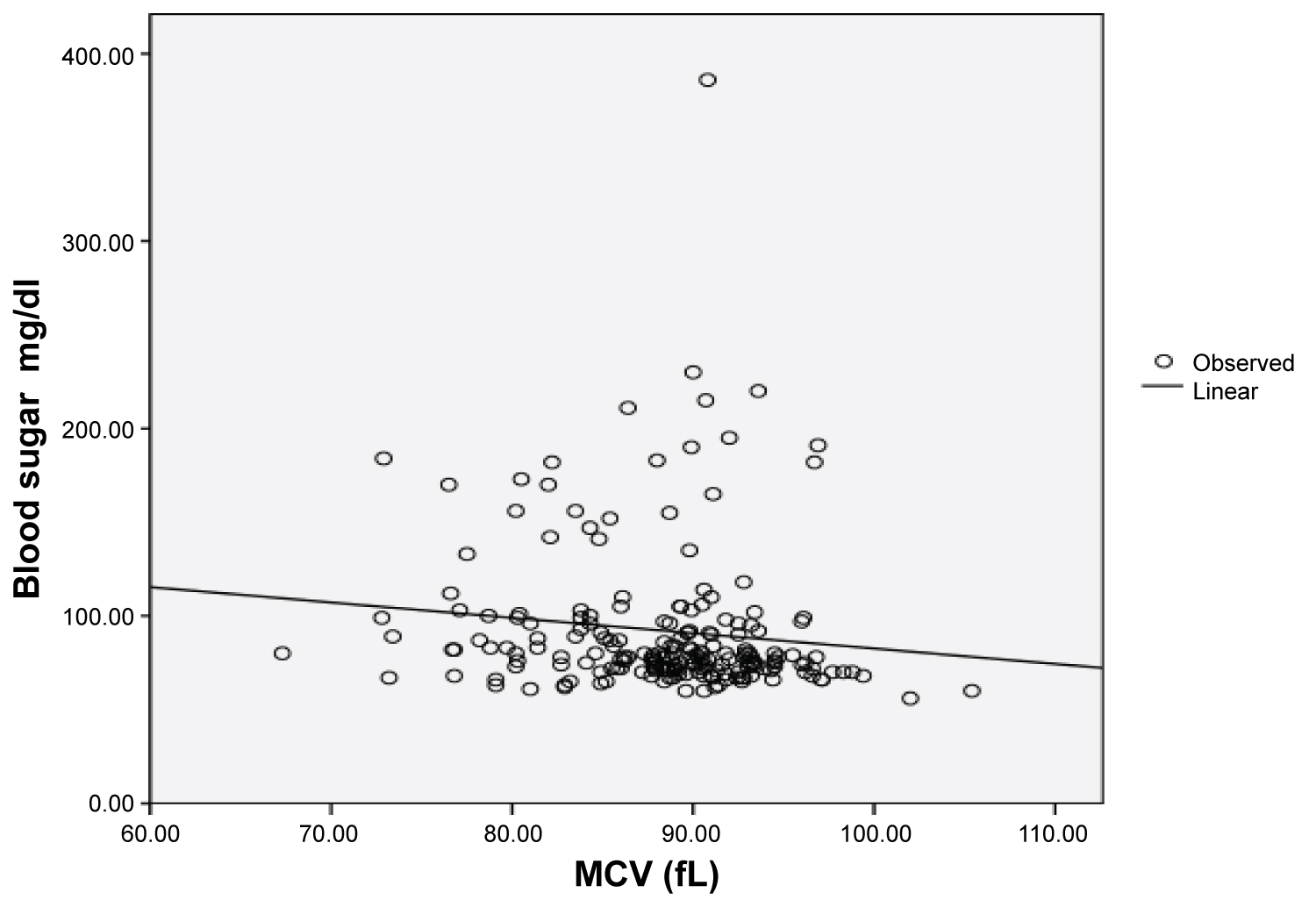Hemoglobin A1c levels and blood sugar is a diagnostic tests used for diabetes and to determine the developing of diabetic complications. The level of HbA1c is affected by factors such as the Haemoglobin, the age of RBCs in the blood circulation and the Hb glycation rate. The aim of this retrospective study is to assess the relationship of HbA1c levels and blood sugar with haemoglobin concentration, and RBC parameter during female clinic follow-up.
The HbA1c levels of 202 patients was measured by NycoCard reader II analyzer and RBC, Haemoglobin concentration (Hb), hematocrit (Hct), Mean Corpuscular Volume (MCV), Mean Corpuscular Haemoglobin (MCH) and Mean Corpuscular Hemoglobin Concentration (MCHC) was measured by mindray BC-3000 Plus auto haematology analyzer, the statistical analyses were performed with SPSS software version 16.0. The Spearman correlation coefficient was used for the relationship of HbA1c, blood sugar with RBC parameters and Kruskal Wallis test for the comparison of HbA1c and RBC parameters between the Diabetics, pre-diabetic and non-diabetic patients.
The correlation of HbA1c and blood sugar levels with RBC parameter indicates positive correlation with RBC count and negative correlation with MCV and MCH, and the comparison among diabetic, pre-diabetic and non-diabetic patients, the results showed significantly higher mean of RBC count, Hb concentration and Hct in diabetic patients, and the mean MCV and MCH were significantly higher in non-diabetic compared with pre-diabetic and diabetic.
The low level of HbA1c has been found in shorten RBCs lifespan, which is affected by RBC parameters and decrease of RBC lifespan in hyperglycaemia patients. Therefore, this study concludes that the RBC parameters are an excellent tool parallel with HbA1c and blood sugar for the assessment of diabetes patients.
HbA1c, Blood sugar, RBC parameters
Hemoglobin A1c (HbA1c) levels is one of the diagnostic tests used for diabetes and managing hyperglycemia in uncontrolled diabetic patients [1]. It is synthesis from the glycation of the terminal unit of the β-chain of haemoglobin, and there percentages determined by the plasma glucose level during last six to eight weeks [2], it has been used to evaluate the level of metabolic control and to determine the developing of diabetic complications, as well as measuring the quality of diabetes care [3].
Anaemia is one of the fundamental elements that effect theHbA1c values by increased the Red Blood Cells count (RBCs) leading to decrease HbA1c levels, which it has been found in blood loss, haemolysis, haemoglobinopathies, red cell disorders, myelodysplastic disease and in patient with haemolytic anaemia, these observations indicated that HbA1c is a very poor marker for diabetic patient with haemolytic anaemia [2,4-7]. While the decreased in RBCs count leading to an increase in the glycation rate of the Hb which contributes to the high value of HbA1c as shown in patients with splenectomy or iron deficiency anaemia [8].
Epidemiological and clinical studies suggested that iron deficiency anaemia causes an increase of HbA1c levels and reduced after iron therapy [9-12]. The level of HbA1c is affected by factors such as the Hb content of reticulocytes, the mean age of RBCs in the blood circulation and the Hb glycation rate [13,14]. The aim of this retrospective study is to assess the relationship of HbA1c levels and blood sugar with haemoglobin concentration, and RBC parameter during female clinic follow-up.
This retrospective study of 202 patients among them is 71 patients' non-diabetic, 88 patients pre-diabetic and 43 diabetic during female clinic follow-up at Albaraa hospital from February to December 2019. The HbA1C was measured by NycoCard reader II analyzer using the boronate affinity chromatography that calculates the ratio between glycated haemoglobin and total haemoglobin after lysing of RBC. RBC, Hb, Hct, MCV, MCH and MCHC, was measured by mindray BC-3000 Plus auto haematology analyzer for in vitro diagnostic use in clinical laboratories, and random blood glucose level was performed by Enzymatic Colorimetric (GOD-PAP) technique using biomaghreb kit measured 4040 photometer.
The statistical analyses were performed with SPSS software version 16.0. The Spearman correlation coefficient was used for the relationship of HbA1c, random blood sugar with RBC parameters and Kruskal Wallis test was used for the comparison of HbA1c and RBC parameters between the Diabetics, pre-diabetic and non-diabetic patients.
Two hundred and two female with a mean age 36-years-old refereed to female's clinic, there were 71 non-diabetic, 88 pre-diabetic and 43 diabetic patients were included in this study, the correlation results of HbA1C, random blood sugar with RBC parameter indicated there was significant positive correlation of HbA1c with RBC count (p < 0.007) (Figure1), and insignificant positive correlation with Hct (p < 0.987), while there were significant negative correlation with MCV (p < 0.000) (Figure 2), MCH (p < 0.024) (Figure 3), but there were insignificant negative correlation with Hb concentration and MCHC (Table 1).
Table 1: The summary of Spearman correlation coefficient between HbA1c, Blood sugar and RBC parameters 202 patients. View Table 1
 Figure 1: The correlation between the HbA1c levels with RBC count.
View Figure 1
Figure 1: The correlation between the HbA1c levels with RBC count.
View Figure 1
 Figure 2: The correlation between the HbA1c levels with MCV.
View Figure 2
Figure 2: The correlation between the HbA1c levels with MCV.
View Figure 2
 Figure 3: The correlation between the HbA1c levels with MCH.
View Figure 3
Figure 3: The correlation between the HbA1c levels with MCH.
View Figure 3
The correlation of blood sugar with RBC parameter showed significantly positive correlation with RBC count (p < 0.000) (Figure 4) and significant with Hb concentration (p < 0.060) (Figure 5), while it was significant negative correlation with MCV (p < 0.001) (Figure 6), MCH (p < 0.015) (Figure 7), and it was an insignificant correlation with Hct and insignificant negative correlation with MCHC (Table 1).
 Figure 4: The correlation between the blood sugar levels with RBC count.
View Figure 4
Figure 4: The correlation between the blood sugar levels with RBC count.
View Figure 4
 Figure 5: The correlation between the blood sugar levels with Hb concentration.
View Figure 5
Figure 5: The correlation between the blood sugar levels with Hb concentration.
View Figure 5
 Figure 6: The correlation between blood sugar levels with MCV.
View Figure 6
Figure 6: The correlation between blood sugar levels with MCV.
View Figure 6
 Figure 7: The correlation between the blood sugar levels with MCH.
View Figure 7
Figure 7: The correlation between the blood sugar levels with MCH.
View Figure 7
Table 2 summarizes the comparison of the RBC parameters mean values among diabetic, pre-diabetic and non-diabetic patients, the results showed that the mean RBC count in diabetic patients were significantly higher (4.4 × 1012/L) than in non-diabetic (4.2 × 1012/L) and pre-diabetic (4.1 × 1012/L) (p < 0.000), the Hct values and the mean Hb concentration were significantly higher in diabetic cases (Hct = 38.1%, Hb = 11.3 g/dl) followed by non-diabetic (Hct = 37.1%), Hb = 11 g/dl) and pre-diabetic (Hct = 35.7%, Hb = 10.6 g/dl), (p < 0.006; Hb; p < 0.006), while the mean MCV and the mean MCH were significantly higher in non-diabetic (MCV = 89.4 fL, MCH = 26.4 pg) compared with pre-diabetic (MCV = 88.4 fL, MCH = 26.2 pg) and diabetic (MCV = 85.6 fL, MCH = 25.4 pg) (MCV; p < 0.001, MCH; p < 0.028) and there were no significant result with MCHC were observed (Table 2).
Table 2: The comparison of the mean RBC parameters among Non Diabetic, Pre-Diabetic and Diabetic patients. View Table 2
HbA1c level has an important role for clinical diagnosis of diabetes [15] and it has been affected by anaemia in both ways positively and negatively according to the type of anaemia, such as blood loss, and haemolytic anaemia may increase RBC turnover and decrease HbA1c level, while iron deficiency anaemia and decrease in ferritin level contributes to an increase in RBC lifespan leading to an increase of HbA1c, [4,10], therefore RBC lifespan is one of the factors affecting HbA1c level production [16]. Our study showed a significant negative correlation of HbA1c with MCV and MCH and a significant positive correlation with RBC count, these observation supports the previous studies of inverse correlation between MCH and HbA1c in pregnant women [17], negative correlation of HbA1c with Hb, MCV and MCH in diabetic patients and premenopausal women [18-20] and positive correlation with RBC count in premenopausal women [19]. While our study is differ from the study of adult with no history of diabetes, which showed a significantly positive association between MCH, MCHC, RDW with HbA1c [21] and positive correlation with Hct, Hb and MCHC values in non-diabetic pregnant women [13].
RBC lifespan decreased in hyperglycaemia patients [22] and affected negatively by MCV, MCH and positively by MCHC [23], therefore this study designed to assess the correlation of blood sugar with RBC parameter and the results showed a positive correlation of blood sugar with Hb concentration and RBC count, while there was a negative correlation with MCV and MCH, this observation supports the relationship of RBC parameters with blood sugars levels.
Two hundred and two patients divided into three groups according to their HbA1c level non-diabetic (4-5.6), pre-diabetic (5.7-6.4) and diabetic (≥ 6.5) has been classified by American Diabetes Association [24]. Our result showed non-diabetic group has significantly higher mean MCV and MCH than pre-diabetic and diabetic groups, while diabetic group has significantly higher mean RBC, Hb concentration and Hct than non-diabetic and pre-diabetic groups, these results disagree with the previous study which indicate that RBC count increased in pre-diabetic patient and decreased in patient with diabetes mellitus [25].
HbA1c and blood sugar levels is an excellent tool for diabetes diagnosis, it has been shown that RBC lifespan decreased in hyperglycaemia patients [22], and the low level of HbA1c has been found in shorten RBCs lifespan [26], also MCV and MCH are factors affecting RBC lifespan [20,23]. Our results indicate that MCV and MCH values increased in patients with lower levels of HbA1c and non-diabetic patients, while RBC count increased in patients with higher levels of HbA1c, and diabetic patients have the highest mean RBC count and Hb concentration while non-diabetic patients have significantly higher mean MCV and MCH. This study provide clear understanding of the multiple factors that determine HbA1c in whole blood and we conclude that the using of HbA1c and blood sugar only as a diagnostic tool may gives false patient assessments, therefore RBC count, MCV, MCH, and Hb concentration is needed to be bounded with HbA1c level and to identify the anaemia type for more accurate diabetic assessments. Correlations study of RBC parameters and anaemia type with other diabetic laboratory investigations and other glycemic control investigation such as oral glucose tolerance test is needed to assess the importance of this observation and provide a more complete understanding of diabetic patients.
This work is supported by Albaraa Hospital Laboratory department and the group would like to express their deep appreciation and indebtedness particular to Dr. Alhadi Araibi and Mr. Abdullah Kredan for their support and understanding the useful of this study.